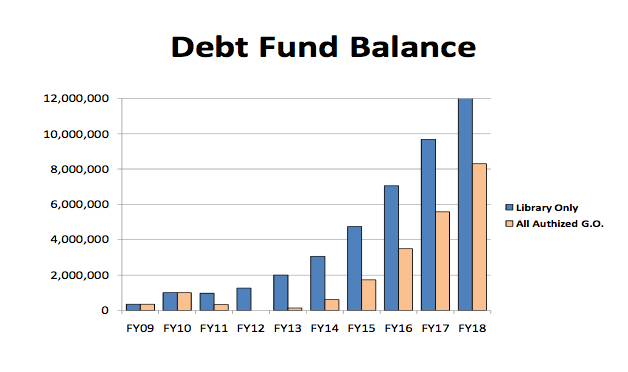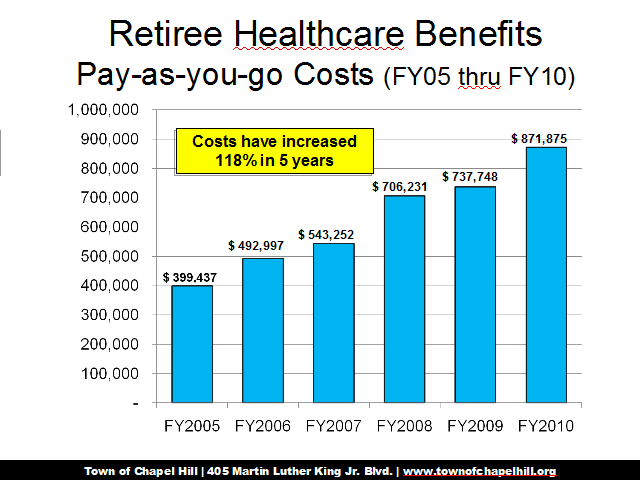Ron Stutts and WCHL 1360 invited me to do a commentary on a Chapel Hill issue.
I chose to speak out on the fiscally imprudent idea that we can “have our cake and eat it too”.
Run this and the following four year’s budget numbers, look at anticipated impacts – funding Town retirees’ health-care, fixing Police Headquarters, meeting our clean water responsibilities under the Lake Jordan compact, the doubling in demand on our social services, etc. – and it becomes clear – we can walk away now from the discretionary Lot #5 project – at little additional cost to the taxpayer – or do the Library expansion next year.
We can’t do both.
Thanks to Ron and crew for somehow squeezing 10 pounds of commentary [MP3] into a 5 pound bag. Amazing!
Jan. 25th the Council considered two projects with major financial impacts – the Library expansion and the problematic Lot #5 private/public development project.
After discussing their options at length, they decided to postpone approval of the Library expansion pending a more thorough review of the Town’s spending priorities during the Town’s normal budget process which, by the way, kicks off Wednesday, Feb. 3rd.
This was a reasonable and prudent course of action given the serious fiscal condition of the Town, the weakened economy, continued expectations of poor revenues and Council’s touted commitment to public participation.
Unfortunately, the Lot #5 project didn’t get the same level of concern.
The Town’s debt has doubled to $55M over the last 5 years. It’s been used to fund necessary and discretionary capital improvements like the construction of the new Aquatics Center – which at about $7M was almost on budget – and the Town Operations Center – which at $52M went roughly $10M over-budget.
Supporters claim the typical household will ONLY pay $40 more a year but that $40 only covers the increased cost of operating the Library and not the cost of discharging the $16M bond debt.
The Town Manager says that as we payoff existing obligations we can issue new bonds without increasing taxes. This might be true through 2011, but as the Town’s finance director pointed out, from 2012 on the construction debt pushes our overall debt very close – maybe even exceeding – the level necessary to keep our Town’s AAA bond rating.
At that point a tax increase is certain.
The Town Manager’s analysis is also rather one dimensional – challenges like the Town’s rapidly growing unfunded retirement obligations – projected to be as much as $56M or replacing Police headquarters – $10M if Council had purchased Dawson Hall – were not considered.
So what about Lot #5? Lot #5 requires 8 to 12M taxpayer dollars and represents the Town’s greatest, riskiest discretionary fiscal liability.
Part of the sales pitch for Lot #5 was the supposed need to stimulate development Downtown.
With Greenbridge nearly built and other Downtown projects on the way it’s clear that we didn’t need a stimulus. In fact, directly across Franklin St. the University at University Square is already putting forward a much more interesting, integrative proposal which better fulfills the goals of the Lot #5 project – and at little cost or risk to our taxpayers.
Given that the cost reductions that allowed RAM Development to lower their gold-plated condo prices haven’t been passed on to the taxpayer, that the number of pre-sold units hasn’t grown in-line with those price reductions, and that the Town still doesn’t know how it plans to borrow that $8 to 12M – now is the time to drop Lot #5.
Three years out – three contract extensions granted – no significant improvement in proposal.
What does this have to do with the Library?
We can have a Library expansion – hopefully starting next year – or we can have Lot #5 – we can’t handle both.
Contact Council – ask them to pull the plug on the Lot #5 project now so that we can take on projects that are more central to Council’s charter.
More information on my website, CitizenWill.org.



